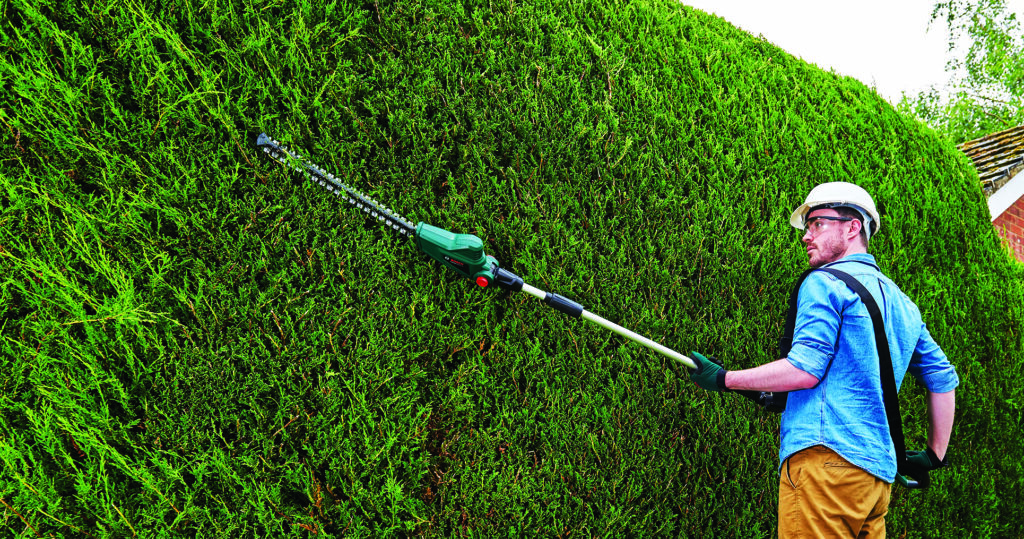Which should you choose, gas vs electric hedge trimmer? If you’ve faced this dilemma, you’re not alone. Aside from knowing the two rely on different power sources, most people are clueless about how gas and electric hedges work, leave alone deciding which hedge trimmer they should buy. Gas and electric hedge trimmers have glaring differences, with each type having its redeeming and limiting qualities, which may appeal to different people. Lucky for you, we’ve compiled this exhaustive guide that illustrates the significant differences between the two and what you should consider when purchasing either. Read on to find out which is best, gas vs electric hedge trimmer.
As the name suggests, gas hedge trimmers are powered by gasoline engines. Gas hedge trimmers are mostly two-stroke type engines and a few four-stroke engines.

More horsepower Trusted Source What's the Deal with Mower Horsepower? » OMC Power Equipment Horsepower as the name suggests is a measure of power. It hails back to the 18th century and was originally used to compare the power of draft horses to the new fad called the steam engine. The mechanical horsepower / imperial horsepower is the equivalent power to 746 watts. It is typically only used in the mechanical world – people would look at you rather funny if you told them your microwave was 1.5hp! www.omcpowerequipment.co.nz means the gas trimmer’s blades rotate faster and have more power than electric hedge trimmers. Also, 2-stroke powered gas hedge trimmers are more mechanically efficient Trusted Source 2stroke / 4stroke - Motorcycle | Yamaha Motor Co., Ltd. Fuel for a 2-stroke engine has a small amount of oil mixed into it. It is called a “2-stroke” because just one up and down movement of the piston—the 2 strokes—performs the full cycle of intake, compression, combustion and exhaust. No intake or exhaust valves are used and instead, small holes called scavenging ports in the cylinder wall are used for drawing in air and expelling exhaust. Because combustion takes place with each revolution of the crankshaft with a 2-stroke, this format puts out more power than a 4-stroke engine and the power has more instantaneous delivery. This are some reasons why 2-stroke engines have a long history of use on many different types of motorcycles. global.yamaha-motor.com , i.e., produce more power per unit of fuel than their 4-stroke counterparts and deliver power almost instantaneously. However, they’re also less environmentally friendly than 4-stroke gasoline engines.
Despite claims that electric car engines can last more than ten years, sometimes more than certain cars, electric hedge trimmers are yet to prove they’re more durable than gas hedge trimmers.
Most gas hedge trimmers from reliable manufacturers can last well beyond six years, provided they’re regularly serviced.
Gas hedge trimmers typically have more moving components in their engines than electric hedge trimmers and therefore require more regular maintenance to remain in good working condition. Also, the trimmer’s blades require regular sharpening and maintenance to remain in top shape. Additionally, the 2-stroke engine gas hedge trimmer lacks an independent lubrication system due to space and size limitations. Instead of the occasional engine oil change as in the 4-stroke, all it needs is a little oil mixed with gasoline fed into its tank.
The average acquisition cost ranges between $150 and $700, a slightly higher figure than the one for similar electric hedge trimmers. There are also variable operational costs, including gasoline and maintenance costs when changing engine oil, filters, spark plugs, etc.
Massive horsepower output paired with quality blades guarantees gas hedge trimmers can cut branches up to one inch thick, and best of all, it would seem effortless to the operator. Further, they do not have power cords attached to them; hence they’re flexible to move around, which is priceless for individuals with huge yards or tall hedges. Gas hedge trimmers are also heavier than their electric counterparts, which may impact usability, especially among individuals not used to lifting and handling heavy objects. Gas hedge trimmers may be hard to use with the added constant vibration.
There are two main concerns related to safety with gas hedge trimmers: excessive noise pollution, which necessitates wearing ear protectors when operating the trimmer, and the harmful Trusted Source #NoMowDays and Other Ways to Trim Your Grass and Your Emissions - Utah Department of Environmental Quality The taller your grass, the healthier your lawn. There is a direct correlation between the height of the grass and the depth of the roots. If you mow your lawn down to two inches, you will have two inches of roots. If you mow at four inches, you will have four inches of roots. That added root mass will make your lawn more drought- and disease-resistant, provide natural weed control, and reduce the amount of water you need to keep your lawn healthy. deq.utah.gov gases released by gasoline-powered hedge trimmers. In extreme cases, the operation of small gasoline-powered engines in poorly ventilated spaces has resulted in several fatalities Trusted Source Carbon Monoxide Hazards from Small Gasoline Engines | NIOSH | CDC Many people using gasoline-powered tools such as high-pressure washers, concrete cutting saws (walk-behind/hand-held), power trowels, floor buffers, welders, pumps, compressors, and generators in buildings or semi enclosed spaces have been poisoned by carbon monoxide. www.cdc.gov . It’s therefore important that gas hedge trimmers are exclusively used in the outdoors, even when it’s left with the engine idling. Provided all other safety recommendations are followed and users stick to the manufacturer’s instructions, gas hedge trimmers are safe.
Electric hedge trimmers rely on electricity to operate and can be battery-powered or corded. Battery-powered, also known as cordless electric hedge trimmers, have to be charged before use, and most brands may require 1 hour to get to full charge.

Like other electric engines, electric hedge trimmers put out massive torque but less horsepower than gas hedge trimmers. Less horsepower output means the electric hedge trimmer’s blades rotate at a slower speed, severely impacting its ability to slice through brush and vegetation.
With proper maintenance and gentle use, electric hedge trimmers can serve for many years; however, they are not as long as equivalent gas hedge trimmers.
Electric hedge trimmers need less intensive maintenance than their gasoline-powered peers, and the maintenance may be in the form of regular cleaning to dislodge debris and dirt. As with other electric engines, a key point in maintaining electric hedge trimmers is ensuring the batteries and the entire power system are clean and well ventilated. Also, the trimmer’s blades require regular sharpening and maintenance to remain in top shape.
The average acquisition costs for electric hedge trimmers in the US range between $50 and $450. With fewer moving parts in its engine than gas hedge trimmers, less friction and heat are generated in operation, which means a reduced need for heat flow management and less wear and tear that may necessitate lubrication or frequent repairs and parts replacement.
As for operational costs, expect to pay an average of $0.05 – $0.08 per hour when the corded electric hedge trimmer is plugged. The battery-powered/ cordless variant costs are slightly higher, but not too much; the costs would still be in cents per hour. However, even with low acquisition and operational costs, electric hedge trimmers may turn into a money pit towards the end of the battery’s life or need to replace the batteries due to poor maintenance.
Electric hedge trimmers weigh less than gas-powered variants, making them a joy to work with, especially when used over extended periods. They’re also relatively quiet, with most of the noise coming from the whirring blades; thus, no need to use any irritating earplugs when operating the trimmer. Sunshine and rainbows aside, electric hedge trimmers may sometimes be a hassle to work with. This is mostly due to the low power output limiting electric hedge trimmers to only slash through brush and vegetation with a maximum of ½ Inch diameter.
Electric hedge trimmers are generally safe to use provided the operator has the required protective equipment, follows recommended safety protocols, and sticks to the manufacturer’s instructions/ manual. However, since most electric hedge trimmers use lithium batteries, they may pose the danger of explosion if improperly stored in a place with inadequate ventilation or close to a heat source.
Irregular disposal of spent battery components harms the environment and other people.
Deciding on the best gas hedge trimmer to buy can be a huge investment, and these four critical points should help ease the dilemma.

The two most common engine variations for gas hedge trimmers are the 2-stroke and the 4-stroke engine. A 2-stroke engine is best for those looking for instant power delivery, with little regard for excessive engine noise and possible environmental pollution. A 4-stroke engine is most suited to individuals that prefer a quitter gas hedge trimmer, with manageable maintenance costs and environmental friendliness.
You may require a gas hedge trimmer with a long or short blade, depending on your needs. You may also opt for the double-sided blades, which have more flexibility, can be operated by either hand, and does the work faster. Blade spacing is another crucial factor to consider. Large spacing is used for commercial and more intense hedge trimming, and smaller spacing is adequate for less intense use at home. However, longer blades may be limited in precision trimming or similar actions.
Since most gas hedge trimmers are heavy, you need to find one that you can comfortably carry while trimming your hedges unless you’re keen on getting a new workout routine. Other noteworthy points include the noise level it generates in operation, ensuring it doesn’t impact your well-being and your neighbors’. Lastly, consider if you can manage its maintenance schedules and if it’s sustainable per your needs or preferences.
Some brush and vegetation are too far up and in awkward positions, which may cause you to discomfort as you try to trim them. A gas hedge trimmer with a rotating head would be most suitable for you if you’re in such a predicament.
A rotating head allows you to reach awkward angles and extreme heights without stretching yourself too much.
Since gas hedge trimmers carry the most financial implication, it would be best to choose what suits your budget and, for some individuals, a rudimentary cost-benefit analysis to ascertain if the acquisition is worth it. When considering the cost implication, it would be best to assess the acquisition and potential operational costs. You can ask the seller or manufacturer about possible maintenance and operational costs like fuel consumption metrics, price of spark plugs, filters, etc. Once you’ve determined the total costs, you should check if it’s within your budget and whether it would make sense to purchase the hedge trimmer. The cost-benefit analysis part may not be necessary for some folks, but it may help prevent unnecessary purchases that may become liabilities down the road.
The following are crucial things to look out for when deciding which electric hedge trimmer to buy.
Electric hedge trimmers can be corded or cordless. Depending on your yard’s size, or your hedges’ height, you can choose to have a cordless hedge trimmer if your yard is large.
Similarly, a corded electric hedge trimmer should suffice if you reach all the parts you need to trim with the hedge trimmer plugged in. You can also add a few adapters to make it work. One of the best cordless electric hedge trimmers, based on numerous positive reviews and features, is the Dewalt DCHT820B by Dewalt.
Considering most handheld hedge trimmers have to be strapped to the body when they’re operated, it would be best to choose one that is light enough for you to carry over extended periods.
You should also try it out to see if you can sustain its weight and whether you can move it around different angles, just like you would do when trimming hedges.
Longer blades allow easy access to brush and vegetation that are hard to reach and trim tougher vegetation or brush. A 20-inch-long blade is adequate to deal with tough and far-placed vegetation. But you should know that a longer blade limits your ability to make precise trims or cuts.
Electric engine technology is still a relatively new concept compared to Internal Combustion Engines (ICEs). Given the significant investment in acquiring an electric hedge trimmer, it is prudent to ensure the manufacturer you’re buying from has a warranty policy in place. This protects your hard-earned money should the machine malfunction, and it’s also a good indicator of the manufacturer’s trust in their products, meaning you’re getting a good deal. A 12-month warranty is a good starting point, and it’s recommended to press for a comprehensive warranty that may cover irregular damage after the end of the warranty period.
Gas and electric hedge trimmers have glaring differences that make it easy to distinguish them. In all the differences presented, it’s evident that each type has its flaws and redeeming qualities that may appeal to different people. The main difference is the power source relied on by each trimmer, which causes the other differences like weight, noise levels, maintenance, costs, etc. As you decide between gas vs electric hedge trimmer, remember every choice is valid, and you should only choose the option that aligns best with your preferences and budget.





